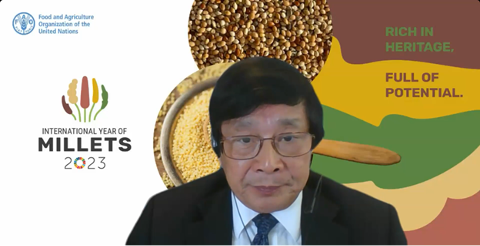Historical aspects of millets were discussed at the second webinar of the International Year of Millets Global Webinar Series

Rome – The second appointment of the International Year of Millets (IYM) Global Webinar Series took place virtually with over 100 participants and provided opportunity to discuss the historical, anthropological, archaeological aspects of millets and their evolving heritage today. Makiko Taguchi, Agricultural Officer of the Plant Production and Protection Division (NSP), facilitated the session.
Jingyuan Xia, NSP Director, opened the meeting and provided a brief introduction on the millets’ nutritional and health benefits as well as their suitability for cultivation under adverse and changing climatic conditions. He highlighted the importance of the proclamation of the IYM by the UN General Assembly to raise awareness of, and direct policy attention to the various environmental, social and economic benefits of millets, their rich heritage and their vast potential.

Millets were among the first domesticated plants and remain a traditional staple crop for millions of people in Sub-Saharan Africa and Asia as the grains can thrive in poor soils, resist crop diseases and pests, and are resilient in adverse climatic conditions. As a fundamental crop for multiple Indigenous Peoples’ food systems around the world, millets have been an important crop for millennia, and even today can help overcome food scarcity in difficult periods, contributing to the food security and nutrition of vulnerable populations.
The event hosted interventions by Nuria Sanz, Regional Director of UNESCO Cairo Office, Egypt, Mikio Kimata, Emeritus Professor of Tokyo Gakugei University, Japan and Haiqing Liu, Young Entrepreneur of Aohan Banner, China and enabled enriching discussion on the archaeological and anthropological aspects in millets tradition in North Africa, on the ethnobotany on the domestication process of millets in Japan and India and on the innovative ways to connect the biodiversity conservation embedded in Globally Important Agricultural Heritage System to the access to markets for local farmers in the farmers-led cooperative in Aohan, China.
Fenton Beed, Senior Agriculture Officer of NSP provided concluding remarks encouraging all stakeholders to leverage the momentum generated by the IYM and actively participate in its global, regional and national initiatives including next webinars focusing on the climate characteristics of millets and the processing opportunities in the millet value chain.
